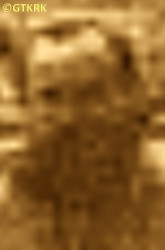Roman Catholic
St Sigismund parish
05-507 Słomczyn
85 Wiślana Str.
Konstancin deanery
Warsaw archdiocese, Poland
full list:
displayClick to display full list

searchClick to search full list by categories
wyświetlKliknij by wyświetlić pełną listę po polsku

szukajKliknij by przeszukać listę wg kategorii po polsku

Martyrology of the clergy — Poland
XX century (1914 – 1989)
personal data
surname
KASZUBSKI
forename(s)
Victor (pl. Wiktor)

function
presbiter (i.e. iereus)
creed
Eastern Orthodox Church ORmore on
en.wikipedia.org
[access: 2014.09.21]
date and place
of death
25.05.1938

Yeniseysktoday: Yeniseysk reg., Krasnodar Krai, Russia
more on
en.wikipedia.org
[access: 2022.08.05]
details of death
In the 1930s disenfranchised as a suspect in „staging a miracle”.
Arrested by the Russians on 05.05.1935 in Owruch.
Accused of „counter–revolutionary activity” — poems were submitted as evidence, written by the defendant in 1932‐1935, including in 1932–1933 and the „holodomor” (genocide of the great famine) caused by the Russians, which led to starvation around 3‐10 million people, commenting poetically on the events.
On 04.11.1935 tried by the murderous special NKVD committee.
Sentenced to three years of exile in Krasnoyarsk Krai.
Sent to the village of Kazachinskoye, the place of deportation of, among others, Poles at the turn of the 19th and 20th centuries, where slaved in a local kovkhoz, i.e. collective farm.
There on 10.02.1938, during „Great Purge” arrested again by the NKVD.
Prob. held in Yeniseisk prison.
Accused of „participation in a kulak–insurgent band”.
On 07.05.1938 tried by the genocidal «NKVD Troika» cangaroo court and sentenced to death.
Murdered in prison.
cause of death
murder
perpetrators
Russians
sites and events
Great Purge 1937Click to display the description, Forced exileClick to display the description
date and place
of birth
23.11.1873

Novohrad‐Volynskyitoday: Zviahel, Zviahel urban hrom., Zviahel rai., Zhytomyr obl., Ukraine
more on
en.wikipedia.org
[access: 2020.11.27]
positions held
till 1935
presbiter (Eng. priest, i.e. iereus) — Ovruchtoday: Ovruch urban hrom., Korosten rai., Zhytomyr obl., Ukraine
more on
en.wikipedia.org
[access: 2021.09.17] ⋄ St Basil OR cathedral parish
till 1889
student — Orthodox Theological Seminary
widower — two children
others related
in death
KASZUBSKIClick to display biography Michael, MARKUSZEWSKIClick to display biography Albin, RESZETYŁOClick to display biography Roman, WASILEWSKIClick to display biography John
sites and events
descriptions
Great Purge 1937: „Great Terror” (also «Great Purge», also called „Yezhovshchyna” after the name of the then head of the NKVD) — a Russian state action of political terror, planned and directed against millions of innocent victims — national minorities, wealthier peasants (kulaks), people considered opponents political, army officers, the greatest intensity of which took place from 09.1936 to 08.1938. It reached its peak starting in the summer of 1937, when Art. 58‐14 of the Penal Code about „counter‐revolutionary sabotage” was passed , which became the basis for the „legalization” of murders, and on 02.07.1937 when the highest authorities of Russia, under the leadership of Joseph Stalin, issued a decree on the initiation of action against the kulaks. Next a number of executive orders of the NKVD followed, including No. 00439 of 25.07.1937, starting the liquidation of 25,000‐42,000 Germans living in Russia (mainly the so‐called Volga Germans); No. 00447 of 30.07.1937, beginning the liquidation of „anti‐Russian elements”, and No. 00485[2] of 11.08.1937, ordering the murder of 139,835 people of Polish nationality (the latter was the largest operation of this type — encompassed 12.5% of all those murdered during the «Great Purge», while Poles constituted 0.4% of the population). In the summer of 1937 Polish Catholic priests held in Solovetsky Islands, Anzer Island and ITL BelbaltLag were locked in prison cells (some in Sankt Petersburg). Next in a few kangaroo, murderous Russian trials (on 09.10.1937, 25.11.1937, among others) run by so‐called «NKVD Troika» all were sentenced to death. They were subsequently executed by a single shot to the back of the head. The murders took place either in Sankt Petersburg prison or directly in places of mass murder, e.g. Sandarmokh or Levashov Wilderness, where their bodies were dumped into the ditches. Other priests were arrested in the places they still ministered in and next murdered in local NKVD headquarters (e.g. in Minsk in Belarus), after equally genocidal trials run by aforementioned «NKVD Troika» kangaroo courts.
Forced exile: One of the standard Russian forms of repression. The prisoners were usually taken to a small village in the middle of nowhere — somewhere in Siberia, in far north or far east — dropped out of the train carriage or a cart, left out without means of subsistence or place to live. (more on: en.wikipedia.orgClick to attempt to display webpage
[access: 2014.12.20])
LETTER to CUSTODIAN/ADMINISTRATOR
If you have an Email client on your communicator/computer — such as Mozilla Thunderbird, Windows Mail or Microsoft Outlook, described at WikipediaPatrz:
en.wikipedia.org, among others — try the link below, please:
LETTER to CUSTODIAN/ADMINISTRATORClick and try to call your own Email client
If however you do not run such a client or the above link is not active please send an email to the Custodian/Administrator using your account — in your customary email/correspondence engine — at the following address:

giving the following as the subject:
MARTYROLOGY: KASZUBSKI Victor
To return to the biography press below:
 Click to return to biography
Click to return to biography








